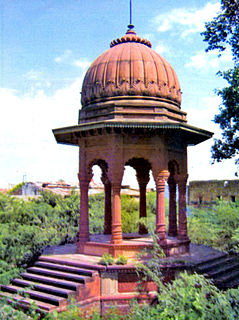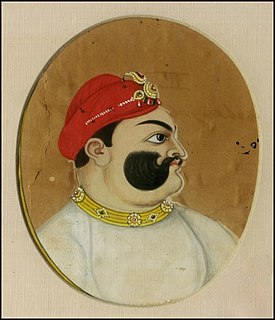
Rao Raja Sri Sawai Pratap Singh Naruka was the founder king of Alwar State. He belonged to the Naruka clan of Kachhwaha dynasty. [1] [2] [3]

Rao Raja Sri Sawai Pratap Singh Naruka was the founder king of Alwar State. He belonged to the Naruka clan of Kachhwaha dynasty. [1] [2] [3]
Pratap Singh Naruka was the son of Rao Muhabbat Singh of Macheri. He was born in 1740. When still young, he was sent to relieve the famous fort of Ranthambor in 1759 which was besieged by the Marathas under the leadership of Gangadhar Tautia. He showed great bravery and ability in the battle that ensued at Kakod (in present Tonk District of Rajasthan). The Marathas fled away.
Once an astrologer at the Jaipur court predicted that the Rao would attain kingly dignity. Fearing his rise, court intrigues were hatched against him. A shot was also fired at him in 1765. Sensing a danger to his life, he left Jaipur immediately reached Rajgarh. From Rajgarh, he went to Jawahar Singh of Bharatpur who welcomed him and bestowed on him the jagir of Dehra village.In 1768, Jawahar Singh insulted the Jaipur Chief by marching without intimation of his motive, through his Stale, to visit the holy lake of Pushkar near Ajmer. On his return journey, he was attacked by the Rajputs of the State he had insulted and defeated at Maonda-Mandholi in the Tanwarati hills, 60 miles north of Jaipur. “The victory was, in a great measure, due to the transfer by Pratap Singh of his supporters to the side of his liegelord on the eve of the battle. He was moved to this either by the insult to his country, which a Rajput could ill bear, or by his desire to become reconciled with his own sovereign.” As a result of his loyalty, Pratap was restored to his fief of Macheri and was also allowed to build a fort at Rajgarh.
Madho Singh of Jaipur had died only four days after the battle of Maonda-Mandholi and Pratap Singh II, a minor succeeded him under guardianship of the mother of his younger brother. Pratap Singh gained great influence at the court through friends in the Council. At this time Najaf Khan, the imperial commander aided by Marathas, proceeded to expel Jats from Agra and then attacked Bharatpur. Pratap Singh aligned himself with Najaf Khan and aided him in defeating the Jats, "This timely succour and his subsequent aid in defeating the Jats, obtained for him the title of Rao Raja and a Sanad for Machheri, to hold direct of the crown.” Pratap Singh found an opportunity of reducing the fortress of Alwar which then belonged to the Jat princes of Bharatpur and seized it. He entered the fort of Alwar in November 1775.
The followers of Pratap Singh began to own him as their feudal lord as soon as the Alwar fort was taken. Some of estates were escheated to the new State. Lands were also snatched from the possessions of Jats. He increased his wealth by relieving a rich man at Thanaghazi of some of his possessions and by plundering Baswa, a town belonging to Jaipur State. This act resulted in a raid by the Jaipur ruler in person, upon Rajgarh fort. The Maharaja failed to take the place and to defeat his former vassal, on account of the alliance he had formed with the Marathas.
He died on September 26, 1791.

Rajasthan is a state in northern India. It covers 342,239 square kilometres (132,139 sq mi) or 10.4 per cent of India's total geographical area. It is the largest Indian state by area and the seventh largest by population. It is on India's northwestern side, where it comprises most of the wide and inhospitable Thar Desert and shares a border with the Pakistani provinces of Punjab to the northwest and Sindh to the west, along the Sutlej-Indus River valley. It is bordered by five other Indian states: Punjab to the north; Haryana and Uttar Pradesh to the northeast; Madhya Pradesh to the southeast; and Gujarat to the southwest. Its geographical location is 23.3 to 30.12 North latitude and 69.30 to 78.17 East longitude, with the Tropic of Cancer passing through its southernmost tip.

Alwar is a city located in India's National Capital Region and the administrative headquarters of Alwar District in the state of Rajasthan. It is located 150 km south of Delhi and 150 km north of Jaipur.

Suraj Mal or Sujan Singh, was a Jat ruler of Bharatpur in present-day state of Rajasthan. Under him, the Jat rule covered the present-day districts of Agra, Aligarh, Bharatpur, Dholpur, Etawa, Gurgaon, Hathras, Mainpuri, Mathura, Mewat, Meerut, Rewari, and Rohtak.

Chhatri are elevated, dome-shaped pavilions used as an element in Indo-Islamic architecture and Indian architecture. Originating as a canopy above tombs, they served as decorative elements. The earliest example of chhatri being used in the Indian Subcontinent were found in the Shrine of Ibrahim in Bhadreswar, constructed between 1159 and 1175 AD.

The Kachhwaha is a Rajput clan found primarily in India. Sometimes families within the clan ruled a number of kingdoms and princely states, such as Jaipur, Bihar, Uttar Pradesh, Madhya Pradesh, Alwar and Maihar.
Patan is a town in the Dhundhar region of the Indian state of Rajasthan. In the 12th century, it became the centre of a minor state called Tanwarawati or Torawati, ruled by Tomar dynasty. Anangpall II, who established the city of Patan and ruled present day Delhi, who is considered to be a direct descendant of Raja Parikshit, son of Abhimanyu and grandson of Arjuna the Pandavas of mahabharata.. “Anangpal II was instrumental in populating Indraprastha and giving it its present name, Delhi. The region was in ruins when he ascended the throne in the 11th century, it was he who built Lal Kot fort and Anangtal Baoli. The Tomar rule over the region is attested by multiple inscriptions and coins, and their ancestry can be traced to the Pandavas " said BR Mani, former joint director-general of the Archaeological Survey of India (ASI).

Alwar is a district in the state of Rajasthan in northern India, whose district headquarters is Alwar city. The district covers 8,380 km2. It is bound on the north by Rewari district of Haryana, on the east by Bharatpur district of Rajasthan and Nuh district of Haryana, on the south by Dausa district, and on the west by Jaipur district.

Maharaja Sawai Madho Singh I was ruler of the state of Jaipur in the present-day Indian state of Rajasthan. He was the younger son of Maharaja Sawai Jai Singh II and became ruler of Jaipur after his brother Ishwari Singh's death.

Jawahar Singh was a Jat ruler of the Bharatpur State. He succeeded to the throne when his father Suraj Mal died in 1763.

Jaipur State was a princely state in India during East India Company rule and thereafter under the British Raj. It signed a treaty creating a subsidiary alliance with the Company in 1818. It acceded to independent India in 1947 and was integrated into India by 1949. Upon integration, the ruler was granted a pension, certain privileges, and the use of the title Maharaja of Jaipur by the Government of India. However, the pension, privileges, and the use of the title were ended in 1971 by the 26th Amendment to the Constitution of India.
Mandholi is a small town of about 1500 people in eastern Rajasthan. It is 5 km from Neem ka thana township and about 90 km from Jaipur. It is famous for Battle of Maonda and Mandholi
The Battle of Maonda and Mandholi was fought between the Rajput rulers of Jaipur and the Jat rulers of Bharatpur in 1767 in Rajasthan. Jawahar Singh of Bharatpur was leading an army back from Pushkar when the forces of Madho Singh of Jaipur met them by Maonda and Mandholi villages, near present-day Neem ka Thana. The battle resulted in the rout of the Bharatpur army by the Jaipur forces.

Bharatpur State, which is also known as the Jat State of Bharatpur historically known as the Kingdom of Bharatpur, was a Hindu Kingdom in the northern part of the Indian subcontinent. It was ruled by the Sinsinwar clan of the Hindu Jats. At the time of reign of king Suraj Mal (1755–1763) revenue of the state was 17,500,000 rupees per annual.

Alwar State is a princely state of Naruka Rajputs with its capital at Alwar in India.
Sawai is a title of honor used in the Indian subcontinent, the word having its root in Sanskrit language.
Ghasera Fort is a ruined fort in Ghasera village in Nuh district of Haryana state in northern India, which has been notified as a protected monument by the state government. Currently, the majority of the residents of the village are Muslim Meos, though Hindus also live there.In the famous battle of Ghasera that took place in 1753 Jat forces led by Surajmal defeated Rajputs and acquired Ghasera fort.
The Battle of Bagru was a military engagement fought between multiple Indian kingdoms in 1748 near the town of Bagru, Jaipur, India. The battle was fought during a succession crisis following the death of Jai Singh II, which left Jaipur without effective leadership.
The Jat people are a community of traditional peasants and herders in Northern India and Pakistan. Originally pastoralists in the lower Indus river-valley of Sindh, Jats migrated north into the Punjab region in late medieval times, and subsequently into the Delhi Territory, northeastern Rajputana, and the western Gangetic Plain in the 17th and 18th centuries.
Narukhand refers to the historical territories which remained under the possession of Naruka Rajputs. Literally, Narukhand means "the country of Naruka Rajputs".